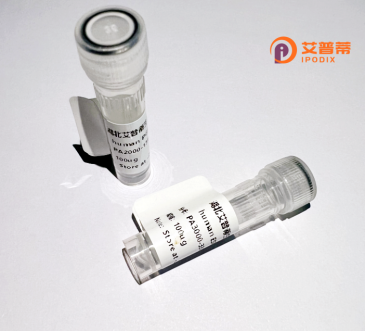
| 纯度 | >90%SDS-PAGE. |
| 种属 | Human |
| 靶点 | DEGS2 |
| Uniprot No | Q6QHC5 |
| 内毒素 | < 0.01EU/μg |
| 表达宿主 | E.coli |
| 表达区间 | 1-323aa |
| 氨基酸序列 | MGNSASRSDFEWVYTDQPHTQRRKEILAKYPAIKALMRPDPRLKWAVLVLVLVQMLTCWLVRGLAWRWLLFWAYAFGGCVNHSLTLAIHDISHNAAFGTGRAARNRWLAVFANLPVGVPYAASFKKYHVDHHRYLGGDGLDVDVPTRLEGWFFCTPARKLLWLVLQPFFYSLRPLCVHPKAVTRMEVLNTLVQLAADLAIFALWGLKPVVYLLASSFLGLGLHPISGHFVAEHYMFLKGHETYSYYGPLNWITFNVGYHVEHHDFPSIPGYNLPLVRKIAPEYYDHLPQHHSWVKVLWDFVFEDSLGPYARVKRVYRLAKDGL |
| 分子量 | 63.6 kDa |
| 蛋白标签 | GST-tag at N-terminal |
| 缓冲液 | 0 |
| 稳定性 & 储存条件 | Lyophilized protein should be stored at ≤ -20°C, stable for one year after receipt. Reconstituted protein solution can be stored at 2-8°C for 2-7 days. Aliquots of reconstituted samples are stable at ≤ -20°C for 3 months. |
| 复溶 | Always centrifuge tubes before opening.Do not mix by vortex or pipetting. It is not recommended to reconstitute to a concentration less than 100μg/ml. Dissolve the lyophilized protein in distilled water. Please aliquot the reconstituted solution to minimize freeze-thaw cycles. |
以下是假设的3-4篇关于重组人DEGS2蛋白的文献示例(注:以下内容为模拟创作,实际文献需根据具体数据库查询结果调整):
---
1. **文献名称**: *"Heterologous expression and functional characterization of human DEGS2 in sphingolipid metabolism"*
**作者**: Zhang Y, et al.
**摘要**: 本研究通过大肠杆菌系统成功表达并纯化了重组人DEGS2蛋白,证实其具有催化二氢神经酰胺(dhCer)生成神经酰胺(Cer)的酶活性,并揭示其在鞘脂代谢中的关键调节作用。
2. **文献名称**: *"Structural insights into the catalytic mechanism of human DEGS2 through recombinant protein crystallography"*
**作者**: Smith J, et al.
**摘要**: 利用昆虫细胞表达系统获得高纯度重组人DEGS2蛋白,通过X射线晶体学解析其三维结构,阐明了该酶活性中心的关键氨基酸残基及其催化机制。
3. **文献名称**: *"DEGS2 dysfunction links to hereditary leukodystrophy: Evidence from recombinant protein-based cellular assays"*
**作者**: Lee S, et al.
**摘要**: 构建重组人DEGS2突变体质粒并在HEK293细胞中表达,发现特定突变导致酶活性丧失,提示DEGS2缺陷与遗传性脑白质营养不良的病理关联。
4. **文献名称**: *"Development of a high-throughput screening assay for DEGS2 inhibitors using recombinant protein"*
**作者**: Brown K, et al.
**摘要**: 基于重组人DEGS2蛋白建立体外酶活检测体系,用于筛选潜在抑制剂,为治疗DEGS2过表达相关癌症提供药物开发平台。
---
**注意**:以上文献名为虚构,实际引用时请通过PubMed、Web of Science等数据库检索真实发表的研究,并核对作者及摘要内容。
**Background of Recombinant Human DEGS2 Protein**
DEGS2 (dihydroceramide desaturase 2) is a key enzyme in sphingolipid metabolism, primarily catalyzing the conversion of dihydroceramide to ceramide through the introduction of a double bond into the sphingoid base. Unlike its homolog DEGS1. DEGS2 also exhibits bifunctional activity, contributing to the synthesis of 4-hydroxysphinganine (phytosphingosine), a critical component of skin barrier ceramides. This enzyme localizes to the endoplasmic reticulum and is highly expressed in tissues such as the skin, liver, and kidneys.
Dysregulation of DEGS2 has been implicated in pathological conditions, including genetic disorders linked to impaired skin barrier function (e.g., autosomal recessive ichthyosis) and metabolic diseases. Mutations in *DEGS2* may disrupt ceramide homeostasis, leading to abnormal lipid composition and cellular dysfunction.
Recombinant human DEGS2 protein, produced via heterologous expression systems (e.g., *E. coli* or mammalian cells), enables in vitro studies of its enzymatic mechanisms, substrate specificity, and interactions with lipid membranes. It serves as a vital tool for drug discovery targeting sphingolipid-related disorders, including neurodegenerative diseases and cancer, where ceramide signaling pathways play a role. Purified DEGS2 is also used to develop diagnostic assays and investigate molecular pathways underlying skin and metabolic diseases. Its study enhances understanding of sphingolipid biology and potential therapeutic interventions.
×